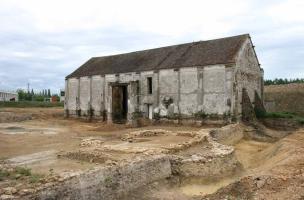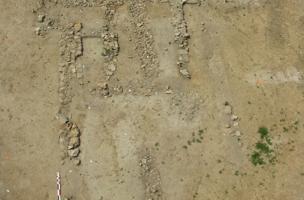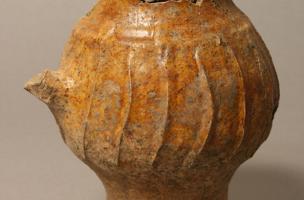You are here
The château du Bois Chaland, a seigniorial dwelling in Lisses (Essonne)
A few kilometres from Paris, a team from the Inrap is at present excavating, curated by the Regional Archaeological Service (Drac Île de France), the remains of a seigniorial dwelling of the Late Middle Ages at Lisses (Essonne).Now known as "La Ferme du Bois Chaland", its archaeological history nonetheless dates back to the 13th century.
Now a farm, the Bois Chaland was a fortified edifice with wall, moat, tower and large dwelling dating from the Late Middle Ages (13th-16th centuries).
The enclosed space of 4080 square metres corresponds exactly to the area of the ancient measure of an arpent.
A "château" covering an area of an arpent
The west corner of the courtyard is occupied by a building with buttresses and pillars whose use it yet to be determined. In the 18th century an enormous barn (still in elevation) was installed more or less on its area.
The whole is part of the symbolic function emblem of the feudal system.
Outside the wall the clayey earth substratum necessitated the construction of numerous ditches to drain the water towards a second larger square enclosure. Ancient maps and aerial photographs dating from 1930 and 1959, i.e. before the building of the nearby motorway A6, allow the restitution of the plan in its entirety.
A long building dating from the later 13th century is doubtless the seigniorial abode known from texts. Nearby, archaeologists have excavated several artisanal workshops (weaving etc.). Numerous ditches contain remains of domestic animals.
The earthenware dishes of a squire
The pottery consists mainly of glazed and much decorated tableware from Parisian workshops: jugs, pots … This pottery dating from the 13th and early 14th century is abundant, whereas that of the second half of the 14th to the 16th century is less so. According to written sources, the dwelling was probably abandoned during the Hundred Years War, the Black Death, and the 1358 "jacquerie" (peasant rising) which ravaged the Ile de France.
Today archaeologists have, for the first time, the complete plan of a seigniorial rural dwelling of the Ile de France and of its evolution into a modern farm. One passes thus, in the same space, from a fragmented medieval dwelling to a concentrated farm which, in modern times, was grouped around an enclosed space. This organisation was to continue right up to the 20th century.







Mahaut Tyrrell
Media communication
Inrap, media partnerships and relations department
+33 (0)1 40 08 80 24
mahaut.tyrrell [at] inrap.fr

